The meadow is ever changing with spring bringing new life and optimism.
April: Order Seeds, Wait and Maintain
April came and went and construction was still not complete; the construction road was still full of construction material, rocks, and debris and it was still hard as a rock. Fewer tufts of grass grew in spots but otherwise it was really getting distressing. Until this point I had thought that we might buy a few plugs (little plants with deep roots that establish quickly) to anchor the meadow. Unfortunately, the window for ordering any plugs quickly closed and I realized that our first-year meadow would be dependent on whatever existed in the main field and seeds in the construction road.
Happily, the existing field was growing and, joy of joy, the very first Milkweed plants started to sprout. It turned out that there were eight distinct patches or communities of Milkweed dispersed around the sides and base of the hill.
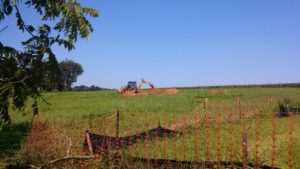 The family wanted a colorful view from the house and the cottage. Given that we could not use plugs in this first year we needed a seed mix that contained some very reliable flowering annuals combined with perennials that could establish themselves for the following year.
The family wanted a colorful view from the house and the cottage. Given that we could not use plugs in this first year we needed a seed mix that contained some very reliable flowering annuals combined with perennials that could establish themselves for the following year.
Cosmos fit the bill because it can grow just about anywhere, is colorful, gay and lively, and it is long lasting. Ernst Conservation Seeds is the most reliable seed source I have used and offered some great mixes that contain Cosmos. I ordered three different mixes from Ernst Conservation Seeds: ERNMX 117 Warm Season Grass, ERNMX 123 Native Upland Wildlife Meadow, and ERNMX 168 Northeast Annual and Perennial Wildflower. I combined the Warm Season Grass and the Native Upland Wildlife mix together and used some on the disturbed area in the middle of the existing field. The rest would be cast over the construction road.
May: Decompaction and Seeding
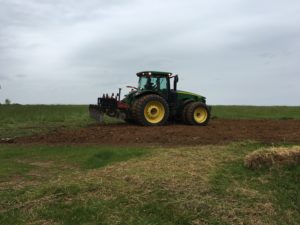
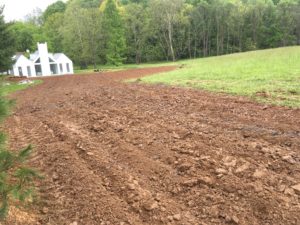 The construction was finally complete and, although the contractor removed many of the larger stones, the road was essentially turned over as is – rock hard, stone studded – definitely not heart-soaring meadow-building material.
The construction was finally complete and, although the contractor removed many of the larger stones, the road was essentially turned over as is – rock hard, stone studded – definitely not heart-soaring meadow-building material.
After lots of research and lots of phone calls I found that a local farming family, the Hicks Brothers, had a soil slitter, a machine that had many of the attributes of a soil spade and that it was available immediately!
The next morning a big tractor with an Edward Scissorhands-like attachment lumbered onto the property. In about two hours, the construction road soil was slit open down to a depth of four feet and was ready for planting.
So why slit or spade instead of tilling? Meadow plants prefer undisturbed soils – like roadsides and neglected fields. Tilling disturbs the soil, opens it up to weeds and it disturbs the upper soil web. Slitting or spading opens the soil but doesn’t turn it over. Instead, it pulls the soil up and gently lets it settle back down with a little fluffiness to allow air and water to circulate beneath the soil.
Seeding the area took a lot longer than slitting – I trudged back and forth across it was wet, muddy, rough terrain hand-casting the seeds. The goal was to have a concentration of flowers near the house and to have a gradual transition from flowers to grass as the field moved up the hill away from the house. The lower area was seeded with 90% Flowers (ERNMX 168) and 10% the grass mix (ERNMX 117 /123 combination). About 20’ into the field this transitioned to a 50/50 mix. After another 20’, it transitioned again to a 10/90 mix.
The seeds were very fluffy and tended to clump together. As per Ernst’s directions I mixed the seeds with cat litter. This gave the mix some heft or weight, allowed for easier disbursement, and enabled me to see where the seed had landed. I had thought I could walk a straight line while hand-casting but I was wrong! I was often very glad to look around and see that I had backtracked on my own path and was about to overseed. Without mixing it with the litter it would have been very hard to get an even distribution and I would have run out of seed very 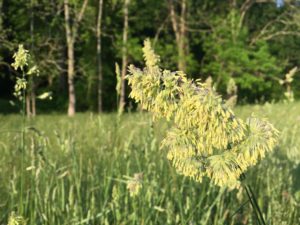
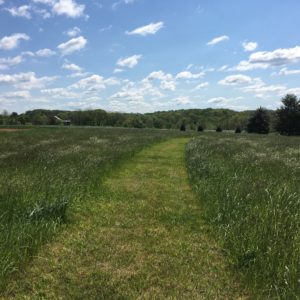 quickly.
quickly.
Meanwhile, up in the existing field, the grasses and the Milkweed were coming up well and the mown paths were clearly visible. Some of the grasses were in full flower. No sign of a Monarch yet but there were the sounds and sights lots of birds and crickets and there were lots and lots of spiders. There were also the first signs of several unwanted invasive plant species including Canada Thistle, Tree of Heaven, Multiflora Rose, Poplar and Cherry trees, and voracious animal species including ground hogs, field mice, and deer.
Depending upon your goals, managing a meadow can run the gamut from broadcast spraying of weed killer to hand weeding. This particular meadow is sited just above a high-value stream and the home’s drinking water well. Those water concerns, combined with the goal of establishing habitat for many creatures, led to a management plan that excluded spraying, relying more on labor-intensive hand pruning. Whenever I walked the fields I carried gloves and my Felco pruners to cut out unwanted trees and roses and to behead thistle. Along these walks I also carried a camera to record the new plants and changing views. I found it frustrating that film could not record the wind rustling through the new grasses, the sounds of birds calling, and the smell of the field. Photos could record growth and capture light; memory would have to fill in the gaps.
In addition to hand weeding, the initial plan to discourage invasives was to include a three-times-a-year mowing regime: once in March, once in June and once in October. The March mow happened on schedule but then came the Monarchs and out went the mowing plan.
June: Monarchs
The existing field became a meadow in June.
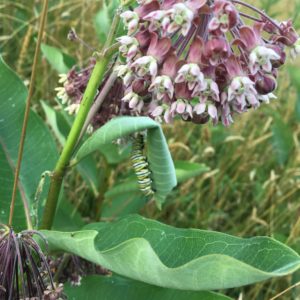
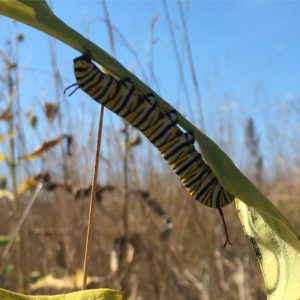 Grasses had been growing pretty consistently since March but now some flowers started to appear including: Dianthus, Milkweed, Chamomile, and Wild Garlic. Butterflies, milkweed beetles, orb spiders, grass hoppers and praying mantis started to appear as well.
Grasses had been growing pretty consistently since March but now some flowers started to appear including: Dianthus, Milkweed, Chamomile, and Wild Garlic. Butterflies, milkweed beetles, orb spiders, grass hoppers and praying mantis started to appear as well.
It was the Monarch Caterpillars that surprised me. Where had they come from? I hadn’t seen a Monarch butterfly but then, one day, in the middle of the month, I looked down and there, drinking water from a small mud patch, was the first Monarch of the year. Then I knew that we couldn’t mow the field in June.
The new field at the construction road was starting to grow, slowly, so I of course worried: would it come up? Would flowers succeed in that awful soil? Should I water? What if it didn’t work? So, I figured, when in doubt, overseed. Following the same planting pattern of: flowers only, then flower/ grass, then grass only, I again hand-cast the construction road. Soon grasses began to
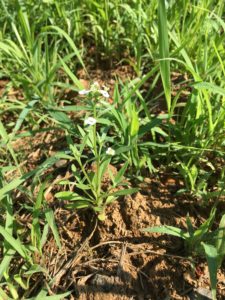 sprout and tiny flowers started to bloom. Relief, happiness and beauty!
sprout and tiny flowers started to bloom. Relief, happiness and beauty!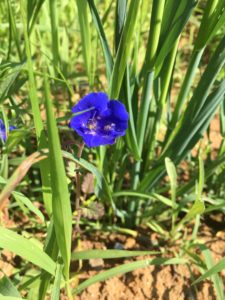
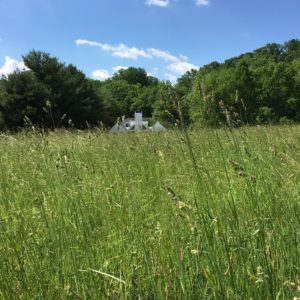
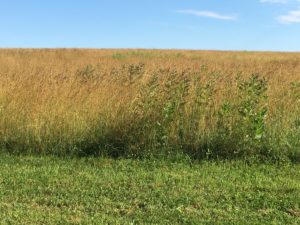
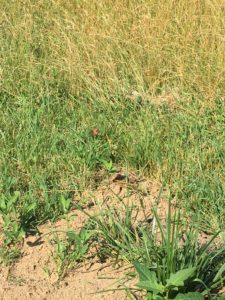
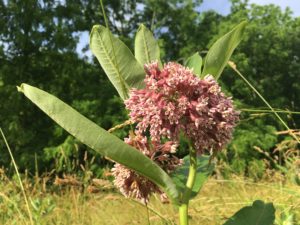
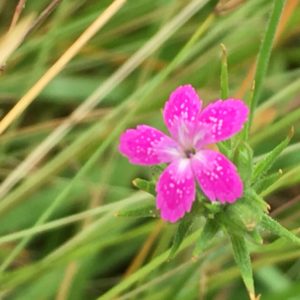

{ 1 trackback }